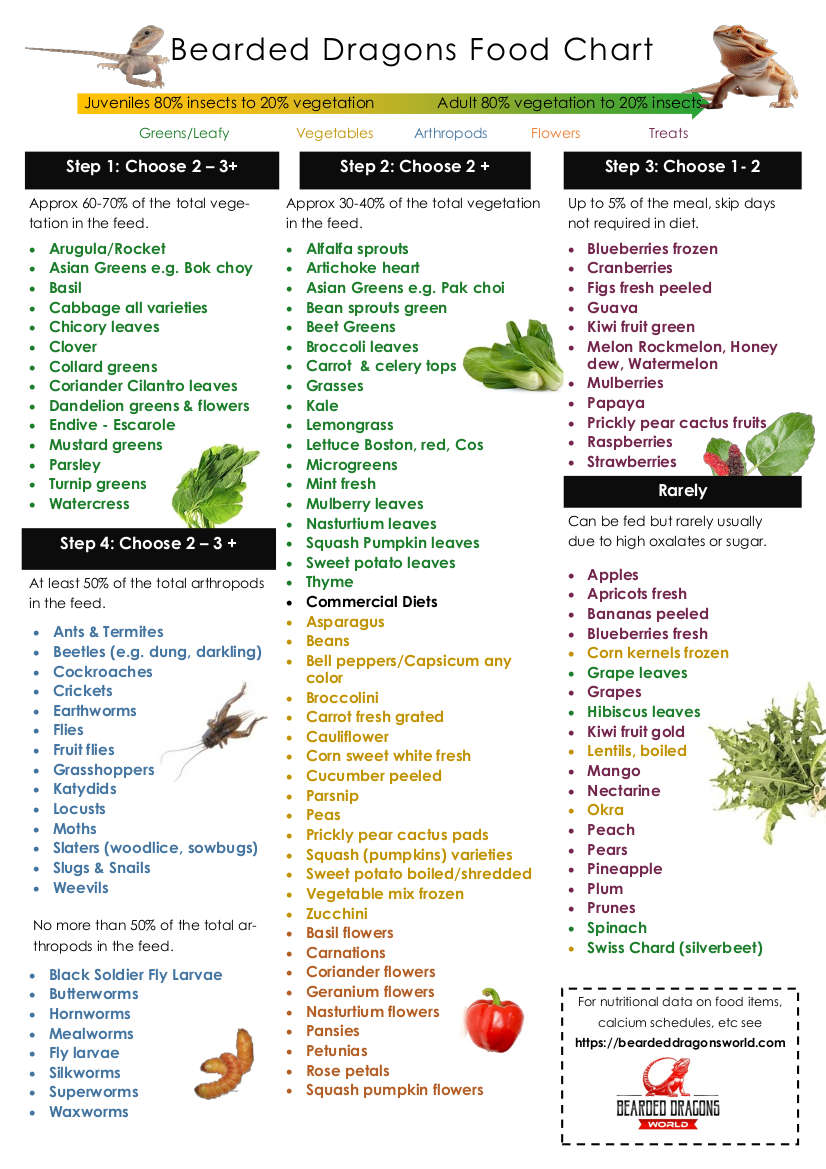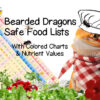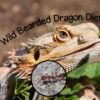In a survey by researchers Barboza et al (2022) almost 50% of bearded dragon owners were not feeding sufficient plant material to adults. Pet owners under 18 years old were more likely to feed too many insects, particularly larvae. This could be a high risk factor in obesity and hepatic lipidosis.
Jump To…
Key Takeaways
- Providing a diet tailored to bearded dragons is essential for their health in captivity.
- A mix of insects, vegetables, and fruits constitutes a balanced diet for bearded dragons.
- It’s important to know which foods are harmful to avoid feeding them to your dragon.
Bearded Dragons Food: Food Types
The bearded dragons safe food lists are in the categories:
- Greens
- Vegetables
- Flowers
- Arthropods (insects)
- Fruit
- Commerical diets for bearded dragons

Bearded Dragons Food: Greens
A mainstay of bearded dragons food are the greens. Greens for bearded dragons are an essential and make up the bulk of the diet.
Aim to comprise the bulk of your bearded dragon’s diet with primarily dark, leafy greens. Add smaller amounts of mixer vegetation, again using variety rather than the same thing often. Rare mixers can be included at times in small amounts.

| Food Item | Frequency | C:P | Calcium (Ca) (mg) | Phosphorus (P) (mg) | Total dietary fibre (g) | Moisture (Water) (g) | Protein (g) | Total sugars (g) |
|---|---|---|---|---|---|---|---|---|
| Arugula (rocket) US data | 3.1:1 | 160 | 52 | 1.6 | 91.7 | 2.58 | 2.05 | |
| Alfalfa sprouts | 0.5:1 | 32 | 70 | 1.9 | 92.82 | 3.99 | 0.18 | |
| Artichoke heart | 34.4:1 | 44 | 1.28 | 5.4 | 84.94 | 3.27 | 0.99 | |
| Asian Greens (Pak choi) | 2.8:1 | 105 | 37 | 1 | 95.32 | 1.5 | 1.18 | |
| Asian Greens Bok choy | 3.0:1 | 83 | 28 | 2.4 | 94.8 | 2.5 | 0.6 | |
| Asian Greens Chinese Flowering Cabbage | 1.8:1 | 70 | 40 | 2.8 | 94.2 | 1.3 | 0.8 | |
| Asian greens Gai choy | 4.6:1 | 130 | 28 | 1.8 | 93.8 | 2.3 | 0.7 | |
| Basil | 2.4:1 | 220 | 91 | 3.3 | 91.6 | 2.6 | 0.0 | |
| Bean sprouts green | 0.3:1 | 10 | 30 | 1.3 | 93.4 | 3.1 | 1.0 | |
| Beet Greens | 2.9:1 | 117 | 41 | 3.7 | 91.02 | 2.2 | 0.5 | |
| Cabbage red | 1.2:1 | 35 | 30 | 3.4 | 88.1 | 2.2 | 2.7 | |
| Cabbage white | 0.8:1 | 32 | 40 | 2.4 | 90.8 | 1.3 | 2.8 | |
| Cabbage, common | 2.0:1 | 47 | 23 | 2.3 | 92.52 | 1.21 | ||
| Cabbage, Savoy | 0.8:1 | 35 | 42 | 3.1 | 91 | 2 | 2.27 | |
| Carrot tops | ||||||||
| Celery tops | ||||||||
| Chicory leaves | 2.1:1 | 100 | 47 | 4 | 92 | 1.7 | 0.7 | |
| Clover (data based on dry matter analysis)* | 4.2:1 | |||||||
| Collard greens fresh | 9.3:1 | 232 | 25 | 4 | 89.62 | 3.02 | 0.46 | |
| Collard greens frozen | 7.4:1 | 201 | 27 | 3.6 | 89.53 | 2.69 | ||
| Coriander Cilantro leaves | 1.4:1 | 67 | 48 | 2.8 | 92.21 | 2.13 | 0.87 | |
| Dandelion greens & flowers | 2.8:1 | 187 | 66 | 3.5 | 85.6 | 2.7 | 0.71 | |
| Endive – Escarole | 1.9:1 | 52 | 28 | 3.1 | 93.79 | 1.25 | 0.25 | |
| Grass Kentucky Bluegrass | 1.0:1 | 0.1 | 0.1 | 8.1 | ||||
| Grass Bermuda | 2.4:1 | 0.53 | 0.22 | 25.9 | ||||
| Grape leaves | 4.0:1 | 363 | 91 | 11 | 73.32 | 5.6 | 6.3 | |
| Hibiscus leaves | 2.7:1 | |||||||
| Kale frozen | 4.7:1 | 136 | 29 | 2 | 91.12 | 2.66 | ||
| Kale | 1.6:1 | 150 | 92 | 3.6 | 84.04 | 4.28 | 2.26 | |
| Lemongrass | 0.6:1 | 65 | 101 | – | 70.6 | 1.8 | – | |
| Lettuce Boston & Bibb | 1.1:1 | 35 | 33 | 1.1 | 95.63 | 1.35 | 0.94 | |
| Lettuce red | 1.2:1 | 33 | 28 | 0.9 | 95.64 | 1.33 | 0.48 | |
| Lettuce, Cos or Romaine | 1.1:1 | 33 | 30 | 2.1 | 94.61 | 1.23 | 1.19 | |
| Microgreens | ||||||||
| Mint fresh | 4.5:1 | 210 | 47 | 7.2 | 84.2 | 3.1 | 0.9 | |
| Mulberry leaves | 2:1 | |||||||
| Mustard greens | 2.0:1 | 115 | 58 | 3.2 | 90.7 | 2.86 | 1.32 | |
| Nasturtium leaves | ||||||||
| Parsley | 1.3:1 | 120 | 94 | 5.0 | 86.2 | 3.9 | 1.0 | |
| Rocket (arugula) Australia | 3.4:1 | 214 | 63 | 2.4 | 91.8 | 3.3 | 0.3 | |
| Spinach | 2.0:1 | 99 | 49 | 2.2 | 91.4 | 2.86 | 0.42 | |
| Squash Pumpkin leaves | 0.4:1 | 39 | 104 | 92.88 | 3.15 | |||
| Sweet potato leaves | 1.0:1 | 78 | 81 | 5.3 | 86.81 | 2.49 | ||
| Swiss Chard (silverbeet) | 1.1:1 | 51 | 46 | 1.6 | 92.66 | 1.8 | 1.1 | |
| Thyme | 3.8:1 | 405 | 106 | 14 | 65.11 | 5.56 | – | |
| Turnip greens | 4.5:1 | 190 | 42 | 3.2 | 89.67 | 1.5 | 0.81 | |
| Watercress | 2.0:1 | 120 | 60 | 0.5 | 95.11 | 2.3 | 0.2 |
Bearded Dragons Food: Vegetables
Bearded dragons food includes an abundance of vegetables.
Aim to comprise the bulk of your bearded dragon’s diet with primarily dark, leafy greens followed by vegetables. Add smaller amounts of mixer vegetables, again using diversity rather than the same thing often.

| Food Item | Frequency | C:P | Calcium (Ca) (mg) | Phosphorus (P) (mg) | Total dietary fibre (g) | Moisture (Water) (g) | Protein (g) | Total sugars (g) |
|---|---|---|---|---|---|---|---|---|
| Asparagus | 0.3:1 | 11 | 43 | 2.2 | 92.8 | 2.5 | 1.4 | |
| Beans | 1.4:1 | 45 | 32 | 2.8 | 91.8 | 1.8 | 2.6 | |
| Bell peppers Capsicum Green | 0.2:1 | 6 | 26 | 1.5 | 94.4 | 0.9 | 2.5 | |
| Bell peppers Capsicum Red | 0.2:1 | 7 | 31 | 1.1 | 93.0 | 1.1 | 4.4 | |
| Broccolini | 0.6:1 | 39 | 61 | 2.5 | 92.2 | 3.2 | 2.3 | |
| Carrot fresh grated | 0.8:1 | 26 | 31 | 3.4 | 88.5 | 0.6 | 6.2 | |
| Cauliflower | 0.5:1 | 22 | 44 | 2.0 | 92.1 | 1.9 | 1.9 | |
| Corn kernels frozen | 0.0:1 | 3 | 71 | 2.5 | 76.0 | 3.0 | 3.0 | |
| Corn sweet white fresh | 0.0:1 | 2 | 89 | 2.7 | 75.96 | 3.22 | 3.22 | |
| Cucumber peeled | 0.7:1 | 14 | 21 | 0.7 | 96.73 | 0.59 | 1.38 | |
| Lentils, boiled | 0.2:1 | 15 | 66 | 4.1 | 74.4 | 7.3 | 0.5 | |
| Okra | 1.3:1 | 82 | 63 | 3.7 | 88.3 | 3.1 | 1.4 | |
| Parsnip | 0.5:1 | 36 | 71 | 4.9 | 79.53 | 1.2 | 4.8 | |
| Peas | 0.2:1 | 25 | 108 | 5.1 | 78.86 | 5.42 | 5.67 | |
| Prickly pear cactus pads | ||||||||
| Squash (pumpkins) many varieties | ||||||||
| Squash Butternut raw | 1.5:1 | 48 | 33 | 2 | 86.41 | 1 | 2.2 | |
| Squash, Queensland Blue peeled | 2.0:1 | 41 | 21 | 2.7 | 83.8 | 2.0 | 4.9 | |
| Sweet potato boiled peeled | 0.8:1 | 28 | 34 | 2.7 | 77.1 | 2 | 6 | |
| Sweet potato shredded | 0.6:1 | 30 | 47 | 3 | 77.28 | 1.57 | 4.18 | |
| Tomato | 0.4:1 | 10 | 24 | 1.2 | 94.5 | 0.88 | 2.63 | |
| Vegetable mix frozen | 0.4:1 | 25 | 59 | 4 | 82.08 | 3.33 | 2.8 | |
| Zucchini | 0.5:1 | 16 | 34 | 1.0 | 94.1 | 2.2 | 1.1 |
Bearded Dragons Food: Flowers
Flowers can make a great addition to a bearded dragons food. Although it is difficult to get data on flowers vets such as Dr Boyer (2021) and the NC State Veterinary Hospital recommend adding flowers to the diet of reptiles.
| Food Item | Frequency |
|---|---|
| Basil flowers | |
| Carnations | |
| Coriander flowers | |
| Geranium flowers | |
| Hibiscus flowers | |
| Nasturtium flowers | |
| Pansies | |
| Petunias | |
| Rose petals | |
| Squash Pumpkin flowers | |
| Guava | |
| Kiwi fruit gold | |
| Kiwi fruit green | |
| Mango | |
| Melon balls frozen | |
| Melon Rockmelon Honey dew | |
| Melon Watermelon | |
| Mulberries | |
| Nectarine | |
| Papaya | |
| Peach | |
| Pears | |
| Pineapple | |
| Plum | |
| Prickly pear cactus fruits | |
| Prunes | |
| Raspberries | |
| Strawberries | |
| Strawberries frozen |
Interestingly the color of the flower can also make a difference in the nutritional content. Research on carnations by Zhou et al (2023) found that of the 4 colors of carnations they tested for antioxidants and anticancer activities the purple carnations lead the pack. It turns out that purple carnations are especially rich in compounds. These compounds not only add a burst of color but also contribute to their ability to fend off harmful invaders, like cancer cells.
While purple carnations top the chart with their health benefits, other colors like green, yellow, and white aren’t far behind. Each color has its own set of nutritional value. For example, yellow flowers might have different types of beneficial compounds, contributing to a well-rounded diet for your bearded dragon.
To take advantage of the spectrum of nutrients flowers offer, try different colors.
Bearded Dragons Food: Fruit, Occasional Treats
In human nutrition, fruits are seen as healthy and we associate this also being good for animals. However, zoo research advises against feeding animals commercially cultivated fruits designed for human tastes. They differ significantly in nutrient composition from wild fruits, containing higher sugar and lower fiber. (Clauss & Hatt, 2011)
Offering fruits to bearded dragons has been associated with tripling their chances of developing dental issues. Research conducted by Mott et al (2020) suggests that fruits might be the primary dietary cause of dental problems in bearded dragons and recommends excluding fruits from their diets.
Additionally, diets rich in sugar, including regular intake of fruits, may lead to health complications in these animals, such as metabolic bone disease.
Fruits for bearded dragons can be an occasional treat, they shouldn’t make up a regular part of the diet. However, some guidelines suggest that keeping fruit to less than 5% of the diet might be acceptable.
When feeding fruit to reptiles, several nutritional factors should be considered to ensure their health and well-being:
- Calcium to Phosphorus Ratio: Fruits often have an inverse ratio of what bearded dragons need, with higher phosphorus than calcium, which can lead to calcium deficiencies and health problems.
- Sugar to Fiber Ratio: Reptiles, especially those not naturally frugivorous, can have difficulty processing high amounts of sugar, which is common in many fruits. A high sugar intake can lead to obesity, diabetes, and gastrointestinal issues. Fiber, on the other hand, aids in digestion. Therefore, fruits with a lower sugar to fiber ratio are preferable, though still in moderation.
- Overall Sugar Content: High sugar content in fruits can lead to health issues such as obesity and dental problems. It’s essential to choose fruits with lower sugar levels and to feed them sparingly as part of a balanced diet.
- Acidity: Some fruits are highly acidic, which can upset a reptile’s stomach or lead to dental issues. Bearded dragons food should be low in acidity and high in calcium.
Bearded dragons food can include the following fruits as mixers less than 5% of the diet or occassionally:

| Food Item | Frequency | C:P | Calcium (Ca) (mg) | Phosphorus (P) (mg) | Total dietary fibre (g) | Moisture (Water) (g) | Protein (g) | Total sugars (g) |
|---|---|---|---|---|---|---|---|---|
| Apple Gala with skin | 0.6:1 | 7 | 11 | 2.3 | 85.76 | 0.25 | 10.37 | |
| Apple Granny Smith with skin | 0.4:1 | 5 | 12 | 2.8 | 85.46 | 0.44 | 9.59 | |
| Apricots fresh | 0.6:1 | 13 | 23 | 2 | 86.35 | 1.4 | 9.24 | |
| Bananas Cavendish peeled | 0.2:1 | 5 | 21 | 2.2 | 76.2 | 1.4 | 12.8 | |
| Blueberries fresh | 0.5:1 | 6 | 12 | 2.4 | 84.21 | 0.74 | 9.96 | |
| Blueberries frozen unsweetened | 0.7:1 | 8 | 11 | 2.7 | 86.59 | 0.42 | 8.45 | |
| Cranberries | 0.6:1 | 8 | 13 | 4.6 | 87.13 | 0.39 | 4.04 | |
| Figs fresh peeled | 2.7:1 | 38 | 14 | 3.3 | 85.9 | 1.4 | 8.1 | |
| Grapes green | 0.4:1 | 10 | 26 | 0.8 | 81.8 | 0.8 | 15.2 | |
| Grapes red globe | 0.5:1 | 10 | 19 | 3.5 | 80.7 | 0.9 | 16.3 | |
| Guava | 0.5:1 | 18 | 40 | 5.4 | 80.8 | 2.55 | 8.92 | |
| Kiwi fruit gold | 0.7:1 | 20 | 29 | 2 | 83.22 | 1.23 | 10.98 | |
| Kiwi fruit green | 1.0:1 | 34 | 34 | 3 | 83.07 | 1.14 | 8.99 | |
| Mango | 0.8:1 | 11 | 14 | 1.6 | 83.46 | 0.82 | 13.66 | |
| Melon balls frozen | 0.8:1 | 10 | 12 | 0.7 | 90.26 | 0.84 | ||
| Melon Rockmelon Honey dew | 0.5:1 | 7 | 14 | 1.0 | 91.2 | 0.5 | 4.7 | |
| Melon Watermelon | 0.4:1 | 5 | 14 | 0.4 | 91.6 | 0.6 | 7.0 | |
| Mulberries | 1.0:1 | 39 | 38 | 1.7 | 87.68 | 1.44 | 8.1 | |
| Nectarine | 0.2:1 | 6 | 26 | 1.7 | 87.59 | 1.06 | 7.89 | |
| Papaya | 2.0:1 | 20 | 10 | 1.7 | 88.06 | 0.47 | 7.82 | |
| Peach | 0.3:1 | 6 | 20 | 1.5 | 88.87 | 0.91 | 8.39 | |
| Pears | 0.8:1 | 9 | 12 | 3.1 | 83.96 | 0.36 | 9.75 | |
| Pineapple | 0.2:1 | 105 | 490 | 10.3 | 88.4 | 20.27 | 7.66 | |
| Plum | 0.4:1 | 6 | 16 | 1.4 | 87.23 | 0.7 | 9.92 | |
| Prickly pear cactus fruits | 2.3:1 | 56 | 24 | 3.6 | 87.55 | 0.73 | 1.02 | |
| Prunes | 0.9:1 | 52 | 58 | 7.8 | 37.1 | 2.3 | 31.0 | |
| Raspberries | 0.9:1 | 25 | 29 | 6.5 | 85.75 | 1.2 | 4.42 | |
| Strawberries | 0.7:1 | 16 | 24 | 2 | 90.95 | 0.67 | 4.89 | |
| Strawberries frozen | 0.9:1 | 21 | 24 | 2.5 | 92.1 | 0.7 | 3.8 |
Bearded Dragons Food: Arthropods (Insects)
Bearded dragons food includes a wide variety of arthropods.
Young bearded dragons food can include insects that will encourage activity, prey that moves around a little fast. This is also great for adult bearded dragons however they tend to prefer slower prey.
Insects are a great source of protein, essential amino acids, trace minerals and fibre. Larval insects are generally high in fat except silkworms and hornworms.
Feeder insects should be gut loaded, fed nutrient-rich foods, as this enhances their nutritional content as bearded dragons food.
Arthropods (Insects) Bearded Dragons Eat Table: Mixers
Less than 50% of the insects fed should be larval insects (Boyer, 2021) due to their high fat content.
Arthropods (insects) to offer include:
| Ants & termites |
| Beetles: Dung beetles (Christmas beetles), mealworm beetles |
| Black soldier fly larvae |
| Butterworms |
| Cockroaches |
| Crickets |
| Earthworms |
| Flies & larvae |
| Fruit flies |
| Grasshoppers |
| Hornworms |
| Katydids |
| Locusts |
| Mealworms & giant mealworms |
| Moths |
| Silkworms |
| Slaters (woodlice, sowbugs, pillbugs) |
| Slugs |
| Snails |
| Spiders |
| Superworms |
| Waxworms |
| Weevils |
Bearded Dragons Food: Commercial Diets
Stahl and Donoghue (2010) suggest that a significant portion of a bearded dragon’s diet, ranging from 60 to 75%, could be comprised of commercially prepared foods. However, others recommend no more than 50% (West Toowoomba Veterinary Surgery).
When adding commercial diets into the bearded dragons meal plan, reduce vitamin and mineral supplements since the commercial diets have these added. Look for a commercial diet that has a guaranted analysis based on dry matter of its product (Boyer, 2021).
Australian Vegetation as Part of Bearded Dragons Food
For Australians or those with access to Australian plants, some natural vegetation can be incorporated into the bearded dragons diet. To diversify the diet and mimic natural habitats, Simpson (2015) recommends including native Australian vegetation such as:
- Eremophilas sp
- Hemiandra pungens
- Croweas
- Correas
- Grevilleas
These native plants could provide a more natural and enriching dietary component for captive bearded dragons food, promoting overall health and well-being.
Other Australian plants known to be naturally included in the wild bearded dragons food through studies of gut content are:
- Austral Bugle (Hajuga australis)
- Gahnia sp
- Glycine spp
- Karngaroo grass (Themeda austalis)
- Xanthosia spp
What Bearded Dragons Shouldn’t Eat
There are specific insects that should be strictly excluded from bearded dragons food which include:
| Food | Description |
|---|---|
| Animal products | Seafood and poultry are not suitable for bearded dragons due to their inability to digest these foods properly. |
| Avocado leaves (and fruit) | Avocado contains persin, which is toxic to many pets, including bearded dragons. |
| Chives | Similar to onions and garlic, can be toxic and cause digestive issues. |
| Citrus fruits | High acidity can upset the digestive system and lead to long-term health issues including: -Lemons -Limes -Oranges -Grapefruits -Tangerines -Pomelos -Citrons -Clementines -Key limes -Ugli fruit (a type of tangelo) |
| Dairy products | Bearded dragons cannot eat dairy products, they cannot digest the lactose. High fat foods can disrupt the metabolism of calcium, essential for bone health. |
| Eggplant leaves | Eggplant, being a member of the nightshade family like tomatoes and potatoes, also has leaves that contain solanine. |
| Garlic greens | Similar to onions, garlic and its greens contain compounds that can be harmful to bearded dragons. |
| Iceberg lettuce | Although not toxic, iceberg lettuce is discouraged as it offers very little nutritional value and can cause diarrhea due to its high water content. |
| Leeks | Can cause digestive issues and potentially lead to blood abnormalities. |
| Onion greens | Onions and their green parts can be toxic to bearded dragons, potentially leading to digestive issues and blood abnormalities. |
| Potato leaves | The leaves of the potato plant contain solanine, a toxin that is harmful to bearded dragons. |
| Shallots | Contains compounds that can be harmful, similar to onions and garlic. |
| Tomato leaves | Tomato plants, particularly their leaves, contain solanine and other toxic alkaloids that can be harmful. |
| Wild Mushrooms | Potential toxicity; specific varieties can be poisonous. Bearded dragons natural diet does not typically include fungi, and the calcium to phorphorus ratio is poor. For example: -button mushrooms have 5mg calcium and 93mg of phorphorus being a ratio of 0.1:1; and -portabello mushrooms have a calcium content of just 3mg with 87mg of phosphorus at a ratio of 0.0:1. |
| Insects | Boxelder bugs (lygaeid bugs) Fireflies (Photinus spp) Monarch butterflies (Donaus plexippus) Queen butterflies (D. gillipus) Lady Beetles (particularly Harmonia axyridis) Insects that are known to have venom, as they can pose serious health risks. Deceased insects may no longer possess nutritional value and might harbor bacteria. Undernourished insects (not fed or not fed gut loading diet). |
Bearded Dragon Supplements Calcium & Multivitamins
Bearded dragons’ diets benefit from additional vitamins and minerals, much like humans do. A well-maintained feeding schedule should include supplements to support their health:
- Calcium supplements are crucial for averting metabolic bone disease, a common issue resulting from a lack of calcium. They are a cornerstone of a bearded dragon’s diet.
- Multivitamins may be necessary for some dragons, and a veterinarian can assist in determining the individual needs of your pet.
Incorporating these supplements is straightforward; they are generally available as powders that can be dusted over the bearded dragon’s meals.
Bear in mind to limit fruit to just 10-20% of their plant intake, avoiding overly acidic options like citrus. Fruits not only offer water content but also bring a variety of vitamins and minerals naturally. It’s also worth noting that other edible flowers can diversify their diet. Remember to serve fruits in small, manageable pieces to facilitate easy eating for your bearded dragon.
Antinutrients in Foods
Compounds such as oxalates, goitrogens and tannins are considered anti nutrients in the bearded dragon diet however, they may also be counteracted by other nutrients.
Dr Boyer (2021) states that oxalates are often of great concern but foods high in oxalates such as spinach can be fed from time to time as part of a good diet. In addition, brasicas do not cause goiters and there is no reason not to feed these foods. In context, all diets should be varied and not focus on a small group of vegetation or arthropods. Anything in excess can harm any species.
With all nutrients and antinutrients data varies significantly from one source to another. Some of the major contributing factors to the variable data are conditions such as season, soil and harvesting practices (Attalla et al, 2014).
Bearded dragons can eat high oxalate foods occassionally without creating any particular health issues.
Why There is so Much Variation in Food Data
By utilising scientific and research data, one can make informed decisions. This article relies on information from international and national food databases and research. However, it is advisable to treat this data as a generalisation rather than absolute truth for your given situation. This is because various national food databases and research studies around the globe offer differing information on food items. Several factors that influence the recorded levels of nutrients and anti-nutrients in each provides are:
- Testing methods
- Fertilisers used
- Soil quality
- Time of harvest
- Transportation conditions
- Leaf age
- Cultivar
One example of just how much data can vary is with a study Mason et al (2000) published. A huge variation of oxalate in the same spinach cultivar (Winter Giant) was found with tests by Mason et al (2000) showing 400-600 mg/100 g fresh weight whereas Gontzea and Sutzescu (cited in Mason et al, 2000) came in at double, 700-900 mg/100g.
References
- Barboza, T., Abood, S. K., & Beaufrère, H. (2022). Survey of Feeding Practices and Supplement Use in Pet Inland Bearded Dragons (Pogona vitticeps) of the United States and Canada. Journal of Herpetological Medicine and Surgery.
- Boyer, T. H. B., DVM, DABVP (Reptile and Amphibian. (2021, November 3). Reptile and Amphibian Nutrition. LafeberVet.
- Clauss, M., & Hatt, J.-M. (2011). Green grocery guide. Zooquaria, 5.
- Mott, R., Pellett, S., & Hedley, J. (2021). Prevalence and risk factors for dental disease in captive Central bearded dragons (Pogona vitticeps) in the United Kingdom. Journal of Exotic Pet Medicine, 36, 1–7.
- Zhou, X., Wang, M., Li, H., Ye, S. P., & Tang, W. (2023). Widely targeted metabolomics reveals the antioxidant and anticancer activities of different colors of Dianthus caryophyllus. Frontiers in Nutrition, 10.






